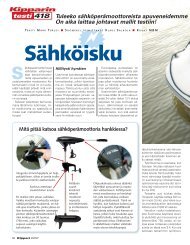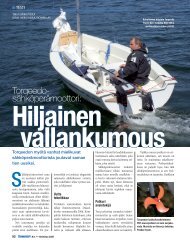1 2 3 - Torqeedo
1 2 3 - Torqeedo
1 2 3 - Torqeedo
Create successful ePaper yourself
Turn your PDF publications into a flip-book with our unique Google optimized e-Paper software.
Cables, switches, fuses<br />
<strong>Torqeedo</strong> connection cable with 35mm 2 cross sectional area.<br />
Background knowledge: Ohm’s law and cable power dissipation<br />
According to Ohm’s law, the power dissipation of a cable is proportional to its electrical resistance and is related to the square<br />
of the electricity flowing through it. More simply expressed: double the current leads to a quadrupling of loss, and ten times the<br />
current leads to one hundred times the loss.<br />
For safety reasons, boats operate in the low-voltage range. That is why even in electrical drives between 2,000 and 3,000 watts<br />
input power, the peak current flow amounts to 80 to 100 amperes.<br />
In comparison: A 1,100 watt electric drill draws 5 amps from a 220 V socket. If you were to operate an electrical drive using<br />
standard household cable then there would be a power loss of approx. 15% caused simply by the cable resistance. In order to<br />
keep losses at a minimum and to avoid the danger of local overheating, manufacturers have to reduce the cable resistance to a<br />
minimum. In order to do so, there are two approaches: the distance between the battery and the motor can be minimized, and a<br />
large diameter cable can be selected.<br />
Catalogue 2007<br />
11









